By Mary Bradley
A Virtuous Cycle
Composting is no longer just a backyard hobby for the ardent gardener. It has Facebook groups and a following from environmentalists, politicians, and scientists. Most praise compost as a means to keep food waste out of landfills and reduce release of methane. While consensus ends there, composting has evolved from a tale of worms, microbes, and bacteria to the realm of politics, emerging technologies, and scientific disputes.
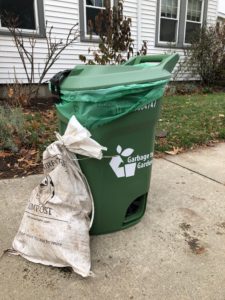
Belmont residents currently have a choice of four curbside composting services and can compare offerings at belmontcomposts.org. (Sara McCabe photo)
For me, however, composting is about magic: Wave one hand over an orange peel clutched in your other hand, and reveal a fistful of dirt. If that’s too mundane a trick, the one-time application of as little as ¼ inch of compost to soil will sequester carbon in the soil for 30 to 100 years. Per acre, the net sequestration is upwards of 55 metric tons of CO2 per year.1,2 Ta-da!
Policy without Passion and Passion without Policy
It is no secret that composting is a sustainable way to recycle organic material. In Massachusetts, a 2014 regulation bans commercial disposal of food waste in landfills by institutions and businesses that produce more than a ton of organic waste each week. Unfortunately, this regulation of the Massachusetts Department of Environmental Protection (MassDEP) is not adequately enforced, with just four regulators charged with overseeing about 1,700 entities. Many schools and businesses have initiated recovery programs, but as much as 80 percent of potential compost is still not diverted from landfills, or about 1,120,000 tons each year.
If conscience or consequence are not enough motivation to divert food waste, eventually economics will be. Tipping fees are rising as space diminishes at landfills, despite the state’s nine anaerobic digesters (an industrial form of composting), operating at less than 75 percent capacity, with one more about to come online.3
Though some municipalities in the Commonwealth have adopted composting policies and programs, smaller institutions and businesses do not have the infrastructure or incentives to compost. In Belmont, attempts to introduce composting have been noble but have lacked the traction and the roadway to meet their goals:
- In Belmont, restaurants such as the Black Bear Café provide their customers with compostable ware and are working to have their landlords supply composting receptacles. Without the receptacles, customers need to dispose of anything compostable in the restaurant’s trash or take it home to put in curbside composting bins. Home composting systems do not generate enough heat to decompose compostable ware, and they will damage recycling systems.
- At the Chenery Middle School, a team of students, teachers, and parents, enthusiastically supported by Principal Mike McAllister, were excited to begin a cafeteria composting program this past summer. The school contracted with an unfinished-furniture company to construct three large refuse centers that would allow students to separate recyclables and compostable waste from trash. According to Principal McAllister, unfortunately the receptacles were not practical. Any change also requires school decisions on who would be in charge of the program, how much it would cost, and who would pay for it.
What Options Do We Have?
Fortunately for our intrepid and environmentally proactive populace, the household composting options range from simple to esoteric.
As individuals, we can compost inside our domiciles or outside in our backyards, in our laundry rooms, or via our front curbs, and while we’re at it, throw in the kitchen sink.
Take It Outside
As home gardeners have long known, outdoor bins accommodate both yard waste and food waste. The complex of living organisms in an aerobic compost pile will break down the organic material, creating temperatures as high as 100–150°F, which destroy pathogens, weed seeds, and fly larvae.
The keys to a successful outdoor bin are oxygen and time. Keeping the compost damp-sponge moist, aerating it often, and balancing two to four times as much carbon as nitrogen will expedite the process. An excess of carbon (pizza boxes, leaves, peanut shells) slows down the decomposition. An excess of nitrogen (food waste, grass clippings, coffee grounds) makes the compost smell bad. But turning it frequently—aeration—balances the carbon-nitrogen ratios; distributes moisture, heat, and oxygen; reduces particle size; and homogenizes the food and yard waste for optimal composting.
When managed correctly, rats are generally not a problem. One keeps rats away by burying food waste under a layer of leaves or other higher-carbon substances, and moistening the entire pile. Planting mint at the perimeter of the bins could be an additional deterrent. If there are pernicious pests in your neighborhood or you just want to be extra cautious, adding fermented food waste, known as bokashi processing, will render your compost pile too acidic for rodents and other animals.
Kitchen Disposal
A kitchen disposal system allows certain foods to be funneled down the drain all the way to the wastewater treatment plant on Deer Island, one of the more than 1,200 Water Resources Recovery Facilities in the United States that can treat shredded food waste with sewage. These use closed-system anaerobic digesters, creating a methane and carbon dioxide gas called biogas, which is captured for use as energy. The remaining wastewater is treated at the sewage plant to produce a nutrient-rich solid digestate, which is broken into fertilizer pellets. Several cities around the country, including Milwaukee and Philadelphia4, encourage residents to install disposals in their kitchen sinks for this purpose. Waste Management, Inc., “one of the two primary landfill companies in the United States,” is a significant proponent of this approach.
Vermicomposting
Vermicomposting, also known as worm composting, consists of an indoor boxed system in which specially ordered red wiggler worms consume limited kinds of food scraps and organic material and then cast off ready-to-use fertilizer. Notably, the nutrients are released at the optimal rate for growing plants. If their environment is kept moist and warm, the tiny red wiggler worms will happily thrive and produce high-quality soil amendment.
Bokashi Composting
Bokashi is Japanese for “shading off” or “gradation.” This two-step system starts with microbial anaerobic fermentation in a bucket indoors, followed by composting either in or outdoors. Bokashi produces neither CO2 nor methane. The process originated in Japan centuries ago, and is gaining popularity throughout the world due to its ease, rapidity, high-quality soil amendment, variety of permitted foods—including meat and dairy—and repelling of rats. Six weeks into my first experiment, it has me near-proselytizing in line at the grocery story and bank.
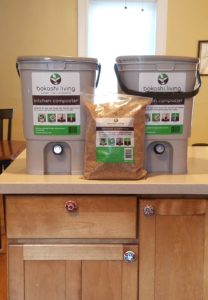
The author’s bokashi starter kit included two bins and bokashi bran to aid fermentation. (Shea Bradley-Hurley photo)
Curbing Your Compost
Curbside composting has been on the upswing in Belmont. For a nominal fee, any of four organizations will whisk away your waste weekly or biweekly. Information about them is available from Belmont Composts!, a recently formed project spearheaded by Julie Wu and operating under the aegis of the Belmont Food Collaborative (the not-for-profit volunteer organization that runs the Belmont Farmers Market), with the goal of increasing curbside composting town-wide.
The commercial composting companies serving Belmont use one or a combination of industrial aerobic methods. The three most common methods are:
- Aerated static ventilation: The pile of waste is ventilated using fans.
- Windrow: The pile of waste is laid out in long rows and turned.
- In-Vessel: The pile of waste is placed in an enclosed facility, ventilated by fans and turned for 3-7 days, after which the waste is typically transferred to windrows to complete the process.
Black Earth has operated their own aerated static ventilation composting site in Manchester-by-the-Sea since 2012. Bootstrap Compost transports your food waste to a Massachusetts farm which uses an in-vessel digester followed by windrows and screening. City Compost currently partners with a few organizations and uses a combination of aerated static piles and windrows. Garbage to Gardens takes Belmont compost to a sorting station in Charlestown, then transports the food waste to farms that use in-vessel digesters followed by windrows and screening.
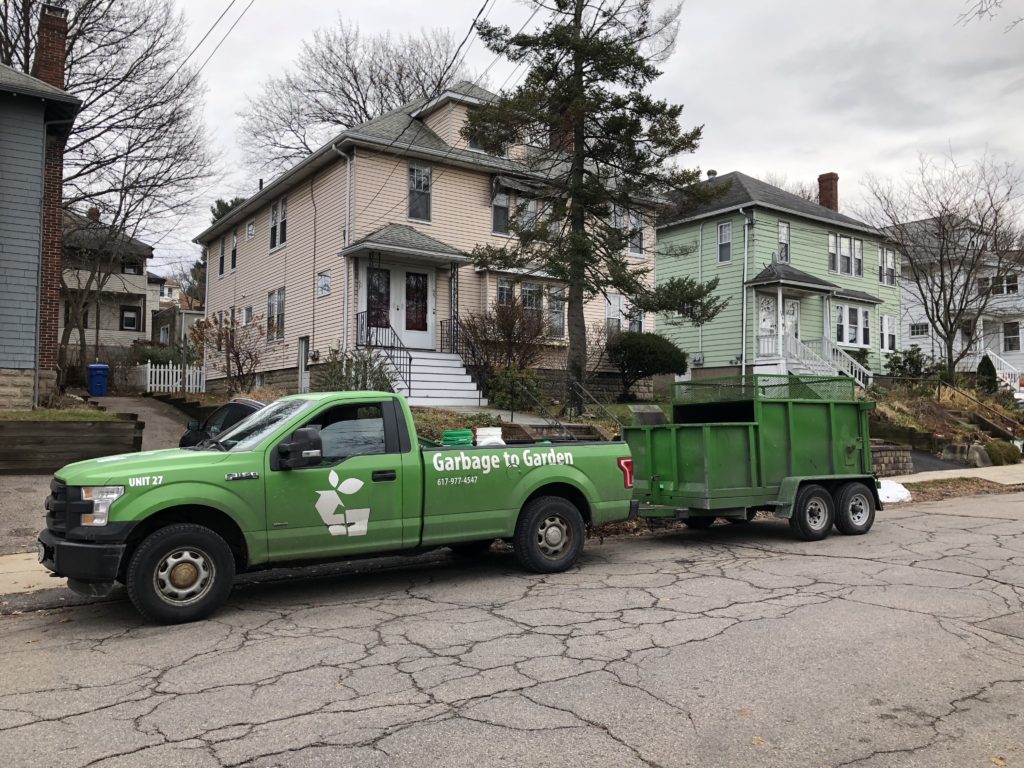
Local commercial composting companies use industrial aerobic methods to break down waste. (Mary Bradley photo)
Making a Choice
Do it yourself, or contract with a commercial company? Each composting option has trade-offs. Outdoor composting incorporates yard and food waste, and provides the greatest environmental benefit. As a gardener you know exactly what has gone into your compost. However, the process requires some manual labor and limits the kinds of foods you can compost. Well-managed outdoor bins do not usually have issues with rats, and once the weather is above freezing, expediting the process with bokashi further discourages vermin and increases the allowable food products.
Vermicomposting has scale and food variety limitations. And worms. In your house.
Bokashi requires an airless container that can be drained, food waste chopped into inch pieces, specially ordered or homemade bran containing effective microbes, and moderate temperature control. It can be ruined by moldy food, large bones, and liquid, but rapidly creates high-quality soil amendment, and the fermentation process provides “compost tea” and rat abatement.
Curbside composting nullifies the rat question; food waste is equally inaccessible in a trash can for landfill or for composting. However, the carbon footprint of trucks collecting food waste from each house and transporting it for processing and distribution may diminish the environmental benefit.
The kitchen disposal has a significantly lower carbon footprint than curbside collection, also creates usable biogas, and doesn’t feed the neighborhood rats. However, the overall range of nonfood items, such as pharmaceuticals and toxins, discharged to the treatment plant can compromise biosolid quality and the long-term carbon sequestration of fertilizer pellets has not been studied. The United States is the only Western country that does not distinguish sludge-source compost from green compost.5
The Future of Waste
Recently Belmont returned to its decades-long flirtation with the idea of building a composting facility at the incinerator site, only to decide for the third time that the externalities would be too high and the benefit too risky. Meanwhile, the uptick in composting within the community speaks to the sea change all around us. More than 250 US cities have instituted curbside collection of yard and food waste, and other cities are encouraging backyard composting.6 All around the globe, communities are adopting composting as a fundamental component of their waste management strategy.
Zero Up
San Francisco set a two-step goal: to reduce waste sent to landfill by 75 percent in 2010, followed by a 90 percent reduction by 2020. The city instituted aggressive public policies, strong public-private sector partnerships, an efficient waste management system, economic incentives, and public education. Still, their efforts stalled around 70 percent between 2007 and 2008. To break through that barrier, they shifted from voluntary to mandatory recycling and composting, and instituted a single-use plastic bag ban, which met the goal with 77 percent reduction in waste by 2010.7
The same year that San Francisco mandated household composting, Seattle passed a resolution to reach 72 percent waste diversion by 2025. Seattle also began requiring food and yard composting for single-family homes. As a Seattle resident at that time, I was keenly aware that the cost to compost was set significantly lower than sending food and yard waste to landfill, which was commensurate with the environmental impact. The program was quickly embraced by the community.8
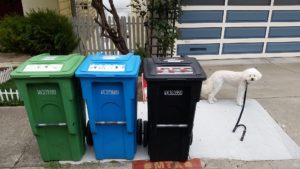
San Francisco residents have a bin for house-hold compostables, which they’re required by law to include in their weekly waste pickup. (Andrea Shippy photo)
Belmont considered a “Pay As You Throw” program in 2018, predicated on a similarly incentivized pricing model. Instead, on September 25, 2018, over objections from Selectman Adam Dash about the excessive size of the required 65-gallon bin, the Board of Selectmen opted for automated trash collection and a five-year contract with the largest residential recycler in North America, Houston-based Waste Management, Inc.
Since introduction of the new contract, Belmont Department of Public Works has seen a large reduction in trash and credits it to an increase in recycling. Possibly the abundance of composting bins on front curbs, and the Belmont Composts! drive initiated at the same time as the new Waste Management, Inc. contract, argue that diverted food waste may be the true cause of decreased waste, but there are no statistics on this.
In two years, the Board of Selectmen will revisit the question of incorporating a “Pay As You Throw” model to complement the automated trash system. Although Waste Management, Inc. does not offer composting, it is possible that compost will be a component of that process if the Commonwealth adopts and enforces composting regulation. At the very least, we may hope to downsize from our unwieldy and near empty cans.
Massachusetts Looks Ahead
In 2020, Massachusetts will adopt a new blueprint for how it disposes of its waste, namely the 2020–2030 Solid Waste Master Plan (SWMP) from MassDEP. (The current plan, from 2010, is available on the mass.gov website).9 We can hope that in time the Commonwealth’s policy catches up with our community’s passion.
For now, there may not be a best option, but the saying has never been more true: do not let the perfect be the enemy of the good. Take care of your trash!
Mary Bradley is co-editor of the Belmont Citizens Forum Newsletter, a veteran home composter, and a recent convert to the bokashi way.
Living the Virtuous Cycle
Fourteen years ago Bonnie Friedman and David Merfeld paid a leaf cleaning service $900 to bag and remove leaves from their yard, and that was the last time. The couple promptly decided composting would be financially, as well as environmentally, beneficial. They designed and constructed three roughly 8x8x5-foot, attached compost bins on their hill and began to transform their waste into compost over a three-year cycle.
Concerned they may attract pests or generate odor, they started with only yard waste but soon began experimenting with vegetable peels, fruits, and tissues. “I couldn’t believe how quickly the tissues disappeared,” Friedman recalls.
- Bonnie Friedman demonstrates the removable slats that allow her to pull out compost, ready to spread on their garden, from her three-bin system (Mary Bradley and Sara McCabe photos).
Over time the list of acceptable materials has grown, as have the locations from which they are harvested. Now almost every room in their house has a receptacle for compostables, and Friedman notes that as a result, their garbage can is nearly empty much of the time.
The family slides yard and food waste down the ramp into the pens or tosses it in from the side. Approximately once a month, Friedman slides down the ramp herself, jumps in the pens, and moves the waste around, then climbs out using one of the side ladders. It’s clear she thoroughly enjoys this activity.
Once a year, Friedman and Merfeld spend a couple of weekends moving the compost. They remove the slats in the bottom wall, pull out approximately 144 cubic feet of compost for their plants and vegetable gardens, replace the slats, and repeat this process, moving the contents of each pen down to the next pen.
Asked about pests, Friedman reflects that although she does not know why, their compost system has never had problems with rats. On rare occasions she has seen raccoons in the top, most accessible, pen.
Rodent-free and carbon offset-rich, the compost system has provided the economic and environmental benefits Friedman and Merfeld first sought. “We used to pay to have our leaves taken away and to have mulch and dirt delivered,” says Friedman, “Now we make our own dirt!”
Composting, a Family Legacy, with Marc Wolman
Marc Wolman, a lifelong resident of Belmont, has been composting all his life and jovially confides that while no book learning is needed for home composting, Let It Rot: The Gardener’s Guide to Composting is great.
Why do you compost?
Why throw away my yard, garden, and kitchen leavings when I can compost them and fertilize my garden?
How long have you been composting?
All my life (My parents did it when I was little).
How would you describe the system you use?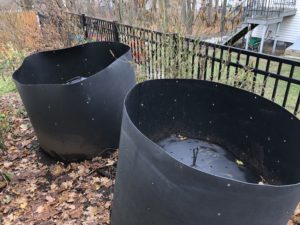
It’s a two-bin system using New Age cylinders from the highway department, set up with each bin at its largest size, three feet in diameter. Once the bin is full, I water and aerate it for 6 to 10 weeks while starting another bin. When it’s nicely aged (you can tell!), I sift it through a half-inch screen. The compost that is smaller than the screen, I apply directly in my yard or bag for future use. The compost that is larger than the screen, I mix back into the active bin.
How long does it take to turn your waste to compost you can use?
I sift the entire contents of a “finished” bin two or three times a year.
How do you use your compost?
For top-dressing and transplanting in my garden.
How concerned are you about achieving the optimum carbon-to-nitrogen ratio?
I mostly just experience its ebb and flow, since everything goes into the mix in season. I screen using half-inch, so lots of woody carbon-y material gets recycled into successive batches. Avocado pits make a great grinding medium.
Would you ever consider using a home composting service?
No.
How do you keep rats out?
Impossible, but best to make the area inhospitable and difficult to penetrate by frequently tending and visiting, keeping the bin covered, compacted, and moist. Mixing in and burying kitchen scraps, watching for tunnels under and holes in bin wall.
REFERENCES
1 “Marin Carbon Project: Science,” Marin Carbon Project, http://www.marincarbonproject.org/marin-carbon-project-science (N.D.)
2 Cal Recycle: Benefits of Compost,” Ca. Gov, https://www.calrecycle.ca.gov/organics/compostmulch/benefitsof#CarbonSeq (N.D.)
3 Abel, David, “The state’s ban on food waste lacks teeth, critics say,” The Boston Globe (Feb. 26, 2019), https://www.bostonglobe.com/metro/2019/02/26/the-state-ban-food-waste-lacks-teeth-critics-say/jU9VKW5C42dO77OgXaF3BP/story.html
4 Gies, Erica, “Landfills have a huge greenhouse gas problem. Here’s what we can do about it,” Ensia.com, https://ensia.com/features/methane-landfills, (October 25, 2016)
5 https://en.wikipedia.org/wiki/Compost
6 Gies, Erica, ibid
7 Alexandre Pouchard, “San Francisco closer to turning zero-waste ambition into reality,” The Guardian (June 17, 2014), https://www.theguardian.com/environment/2014/jun/17/san-francisco-zero-waste-recycling-composting
8 https://earth911.com/business-policy/will-these-10-u-s-cities-achieve-zero-waste/
9 MassDEP 2010 Solid Waste Data Update, https://www.mass.gov/files/documents/2016/08/vn/10swdata.pdf

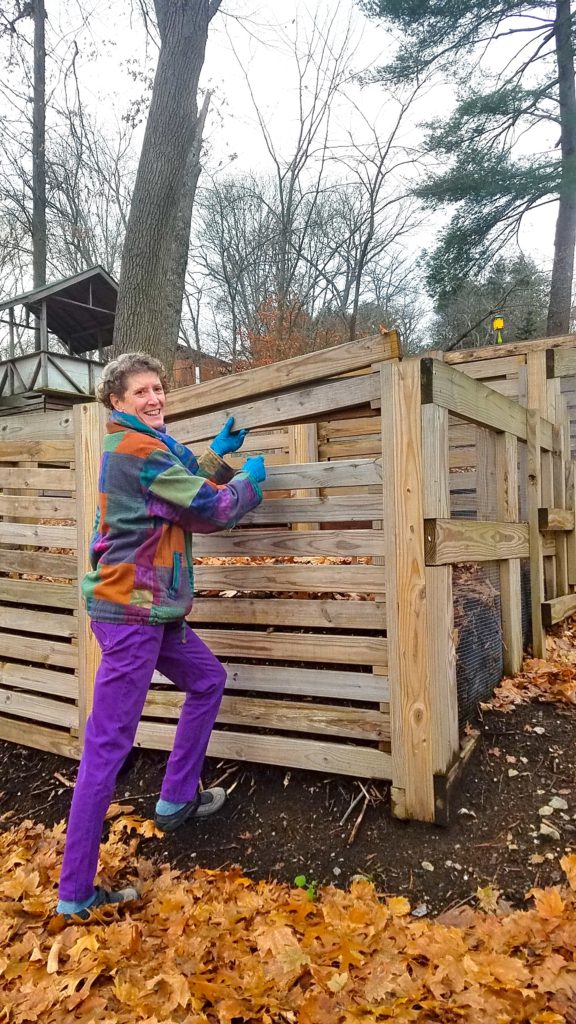
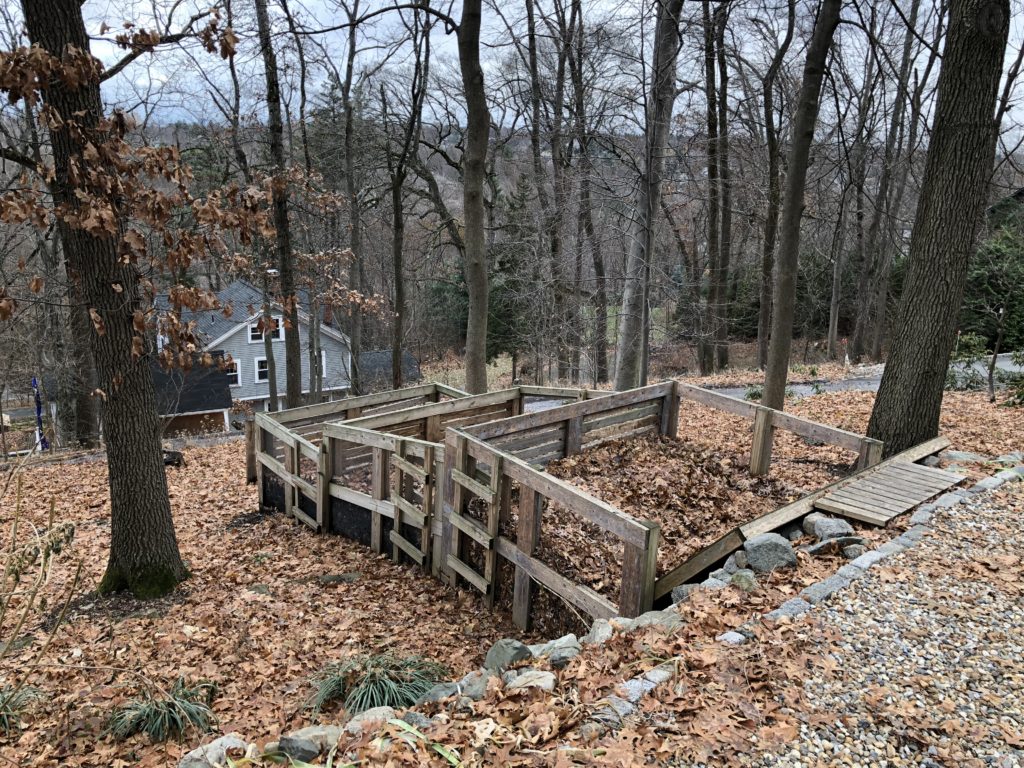

Sorry, the comment form is closed at this time.